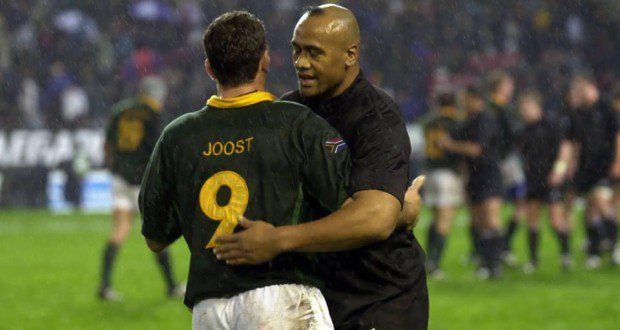#RIPJoost
0South African rugby might be in something of a doldrums at present (at 15’s level) but go back to the decade around the turn of the century and they had a side and players that were genuinely feared and respected.
One of those was the halfback – Joost van der Westhuizen
Hearing his name – once we’d learnt to pronounce it somewhat correctly – was a genuine cause for alarm. He was much better than our halfbacks, could we contain him?
His death at just 45 from the form of motor neurone disease known as Lou Gehrig’s Disease (named after the famed Yankee’s baseballer who also died from it), is both tragic and a reminder than life can be painfully short.
Joost’s arrival on the international stage coincided with South Africa’s return following the Apartheid exile. Two things were immediately apparent; usually halfbacks are the shortest and smallest people on the rugby field, generally ‘normal’ sized people. Joost wasn’t; at nearly 1.9m (6’2” feet in the old language) and over 90kg he was unusually big for the position. The other was those cold blue-grey eyes and the feeling of steely determination they conveyed.
His size allowed him to play the position in a much more physical way than anyone else that had come before him. One of the most enduring images of him is him firing the ball off the back of the scrum to set up Joel Stransky for the winning drop goal in the epic 1995 Rugby World Cup final at Ellis Park, but another is him stopping a rampaging Jonah Lomu earlier in that game one-on-one. Considering the list of people who had failed to manage that during the tournament it wasn’t some ho-hum feat.
He wasn’t all power though; he contained all of the traditional halfback skills just in a bigger frame. Often you’d wonder just how he’d managed to slip through the defence but he would do it time and time again with a sniping burst, and in the finest traditions of Danie Craven he was exceptional with the dive pass. In many respects he redefined the halfback role and our own TJ Perenara is a modern equivalent of that.
The advent of professionalism the following year meant we in NZ got to see more of him, both in Super Rugby for his beloved Northern Transvaal (now the Blue Bulls), and in the Tri-Nations for the Springboks. His battles with George Gregan and Justin Marshall were always an interesting sub-plot to every match; against the All Blacks he wasn’t so much a thorn in the side but more a dagger even if he lost 12 of his 17 outings.
He retired in 2003 after the Springboks exit from that year’s World Cup as their most capped player with 89 Tests in his 111 outings, having captained the side ten times and scored 38 Test Tries. He was inducted into the International Rugby Hall of Fame in 2007, and the World Rugby one in 2014 when the two merged.
Off the field he may have had some personal issues; divorced once, estranged from his second wife, and involved in a high-profile episode with a call-girl that he firstly denied but later admitted. In 2011 came the devastating news that he had been diagnosed with motor neurone disease, for which there is no cure. His death was sadly inevitable and the sight of him confined to a wheelchair was particularly galling, but he used his circumstances to raise awareness of the disease.
The game is poorer for his loss. #RIPJoost
Follow Scott on Twitter

